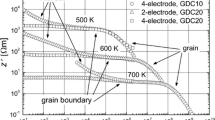Abstract
Magnesium oxide can be added into Gd-doped CeO2 (GDC) as a suitable sintering additive, and the continuous GDC/MgO heterogeneous interface will contribute to the promotion of the oxygen ion transmission. GDC-50vol%MgO composite ceramics were sintered at different temperatures (1350~1500 °C). The phase composition, micromorphology, and electrical conductivity of GDC-50vol%MgO were analyzed by XRD, SEM, TEM, and electrochemical impedance, respectively. There are only GDC and MgO phases in the ceramics sintered at 1350 °C, 1400 °C, 1450 °C, and 1500 °C. As the sintering temperature rises from 1350 to 1500 °C, the average grain size of GDC and MgO increases from 239/274 to 680/651 nm, respectively. The GDC/MgO heterogeneous interface is clear, and many edge dislocations form there. The grain boundary and total conductivities decrease significantly with the rising sintering temperature, and the GDC/MgO heterogeneous interface possesses a higher electrical conductivity than the GDC/GDC homogeneous interface.










Similar content being viewed by others
References
Ning Z, Milin Z, Fucheng X, Cheng W, Zhixiang L, Zongqian M (2012) Fabrication and characterization of anode support low-temperature solid oxide fuel cell based on the Samaria-doped ceria electrolyte. Int J Hydrog Energy 37:797–801. https://doi.org/10.1016/j.ijhydene.2011.04.059
Zhang T (2004) Effect of transition metal oxides on densification and electrical properties of Si-containing Ce0.8Gd0.2O2-δ ceramics. Solid State Ionics 168:187–195. https://doi.org/10.1016/j.ssi.2004.02.015
Ahmed A, Raza R, Khalid MS, Saleem M, Alvi F (2016) Highly efficient composite electrolyte for natural gas fed fuel cell. Int J Hydrog Energy 41:6972–6979. https://doi.org/10.1016/j.ijhydene.2016.02.095
Guo X, Waser R (2006) Electrical properties of the grain boundaries of oxygen ion conductors: acceptor-doped zirconia and ceria. Prog Mater Sci 51:151–210. https://doi.org/10.1016/j.pmatsci.2005.07.001
Ahmad SI, Mohammed T, Bahafi A, Suresh MB (2017) Effect of Mg doping and sintering temperature on structural and morphological properties of samarium-doped ceria for IT-SOFC electrolyte. Appl Nanosci 7:243–252. https://doi.org/10.1007/s13204-017-0567-x
Venkataramana K, Ravindranath K, Madhuri C, Madhusudan C, Pavan Kumar N, Vishnuvardhan Reddy C (2018) Low temperature microwave sintering of yttrium and samarium co-doped ceria solid electrolytes for IT-SOFCs. Ionics 24:1429–1438. https://doi.org/10.1007/s11581-017-2293-5
Badwal SPS, Ciacchi FT (2000) Oxygen-ion conducting electrolyte materials for solid oxide fuel cells. Ionics 6:1–21. https://doi.org/10.1007/BF02375543
Sandhya K, Chitra Priya NS, Rajendran DN, Thappily P (2020) Structural and electrical properties of cerium oxides doped by Sb3+ and Bi3+ cations. J Electron Mater 49:4936–4944. https://doi.org/10.1007/s11664-020-08220-9
Kim D-J (1989) Lattice parameters, ionic conductivities, and solubility limits in fluorite-structure MO2 oxide [M = Hf4+, Zr4+, Ce4+, Th4+, U4+] solid solutions. J Am Ceram Soc 72:1415–1421. https://doi.org/10.1111/j.1151-2916.1989.tb07663.x
Mogensen M (2000) Physical, chemical and electrochemical properties of pure and doped ceria. Solid State Ionics 129:63–94. https://doi.org/10.1016/S0167-2738(99)00318-5
Guo X, Sigle W, Maier J (2003) Blocking grain boundaries in yttria-doped and undoped ceria ceramics of high purity. J Am Ceram Soc 86:77–87. https://doi.org/10.1111/j.1151-2916.2003.tb03281.x
Ge L, Li R, He S, Chen H, Guo L (2012) Effect of titania concentration on the grain boundary conductivity of Ce0.8Gd0.2O1.9 electrolyte. Int J Hydrog Energy 37:16123–16129. https://doi.org/10.1016/j.ijhydene.2012.08.031
Ge L, Li S, Zheng Y, Zhou M, Chen H, Guo L (2011) Effect of zinc oxide doping on the grain boundary conductivity of Ce0.8Ln0.2O1.9 ceramics (Ln=Y, Sm, Gd). J Power Sources 196:6131–6137. https://doi.org/10.1016/j.jpowsour.2011.03.032
Cho YH, Cho P-S, Auchterlonie G, Kim DK, Lee J-H, Kim D-Y, Park H-M, Drennan J (2007) Enhancement of grain-boundary conduction in gadolinia-doped ceria by the scavenging of highly resistive siliceous phase. Acta Mater 55:4807–4815. https://doi.org/10.1016/j.actamat.2007.05.001
Cho P-S, Lee SB, Cho YH, Kim D-Y, Park H-M, Lee J-H (2008) Effect of CaO concentration on enhancement of grain-boundary conduction in gadolinia-doped ceria. J Power Sources 183:518–523. https://doi.org/10.1016/j.jpowsour.2008.05.041
Cho P-S, Cho YH, Park S-Y, Lee SB, Kim D-Y, Park H-M, Auchterlonie J, Drennan J, Lee J-H (2009) Grain-boundary conduction in gadolinia-doped ceria: the effect of SrO addition. J Electrochem Soc 156:B339. https://doi.org/10.1149/1.3046153
Zhou R, Bu Y, Xu D, Zhong Q (2014) Synthesis and characterization of Ca and Sr co-doped ceria electrolytes. Ionics 20:721–727. https://doi.org/10.1007/s11581-013-0999-6
Kim HN, Park HJ, Choi GM (2006) The effect of alumina addition on the electrical conductivity of Gd-doped ceria. J Electroceram 17:793–798. https://doi.org/10.1007/s10832-006-7000-2
Zhang T, Zeng Z, Huang H, Hing P, Kilner J (2002) Effect of alumina addition on the electrical and mechanical properties of Ce0.8Gd0.2O2-δ ceramics. Mater Lett 57:124–129. https://doi.org/10.1016/S0167-577X(02)00717-6
Li B, Wei X, Pan W (2008) Electrical properties of mg-doped Gd0.1Ce0.9O1.95 under different sintering conditions. J Power Sources 183:498–505. https://doi.org/10.1016/j.jpowsour.2008.05.050
Bi H, Liu X, Zhu L, Sun J, Yu S, Yu H, Pei L (2017) Effect of MgO addition and grain size on the electrical properties of Ce0.9Gd0.1O1.95 electrolyte for IT-SOFCs. Int J Hydrog Energy 42:11735–11744. https://doi.org/10.1016/j.ijhydene.2017.02.110
Vashook V, Zosel J, Sperling E, Ahlborn K, Gerlach F, Fichtner W, Schelter M, Guth U, Mertig M (2016) Nanocomposite ceramics based on Ce0.9Gd0.1O1.95 and MgO. Solid State Ionics 288:98–102. https://doi.org/10.1016/j.ssi.2016.01.033
Vashook VV, Zosel J, Schelter M, Ahlborn K, Gerlach F, Fichtner W, Schelter M, Guth U, Mertig M (2018) Nanocomposite ceramics on the basis of magnesium, cerium, and samarium oxides. Russ J Electrochem 54:1176–1185. https://doi.org/10.1134/S1023193518140100
Funding
This work was supported by the Yunnan Ten Thousand Talents Plan Young & Elite Talents Project and the National Natural Science Foundation of China (Grant No. 51462018).
Author information
Authors and Affiliations
Corresponding author
Additional information
Publisher’s note
Springer Nature remains neutral with regard to jurisdictional claims in published maps and institutional affiliations.
Rights and permissions
About this article
Cite this article
Zheng, Q., Zhang, H., Meng, B. et al. Influences of sintering temperature on the electrical conductivity of GDC-50vol%MgO composite ceramics: the role of the GDC/MgO heterogeneous interface. Ionics 27, 269–277 (2021). https://doi.org/10.1007/s11581-020-03811-2
Received:
Revised:
Accepted:
Published:
Issue Date:
DOI: https://doi.org/10.1007/s11581-020-03811-2




